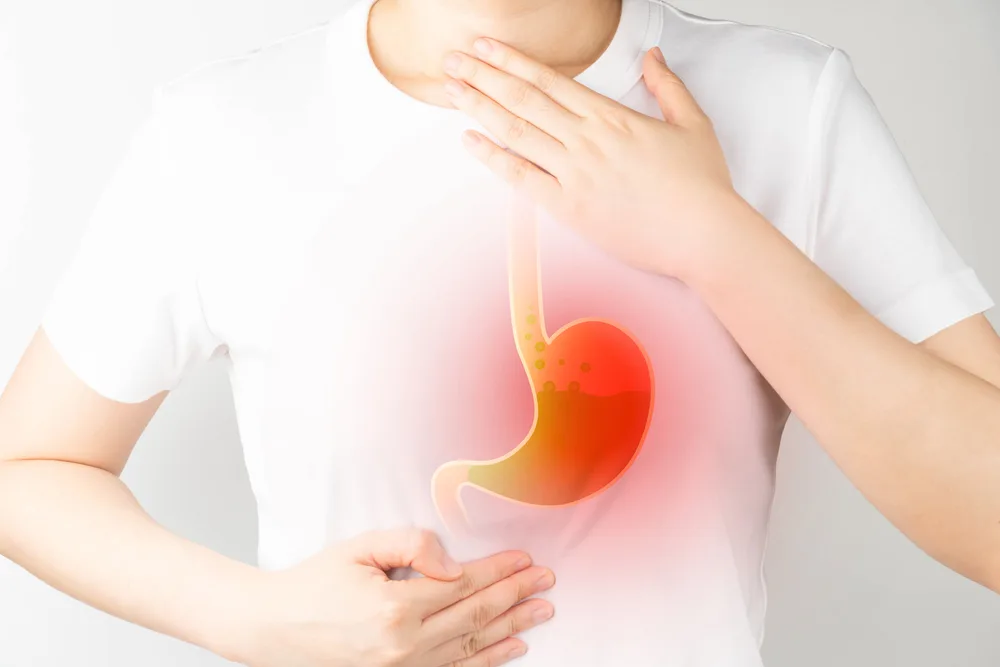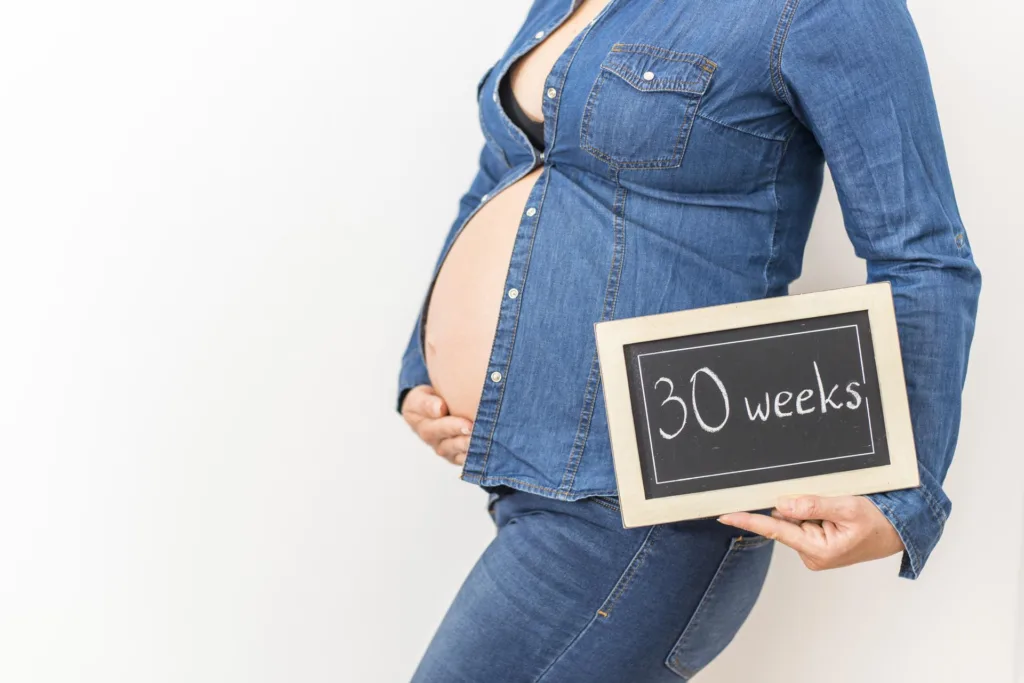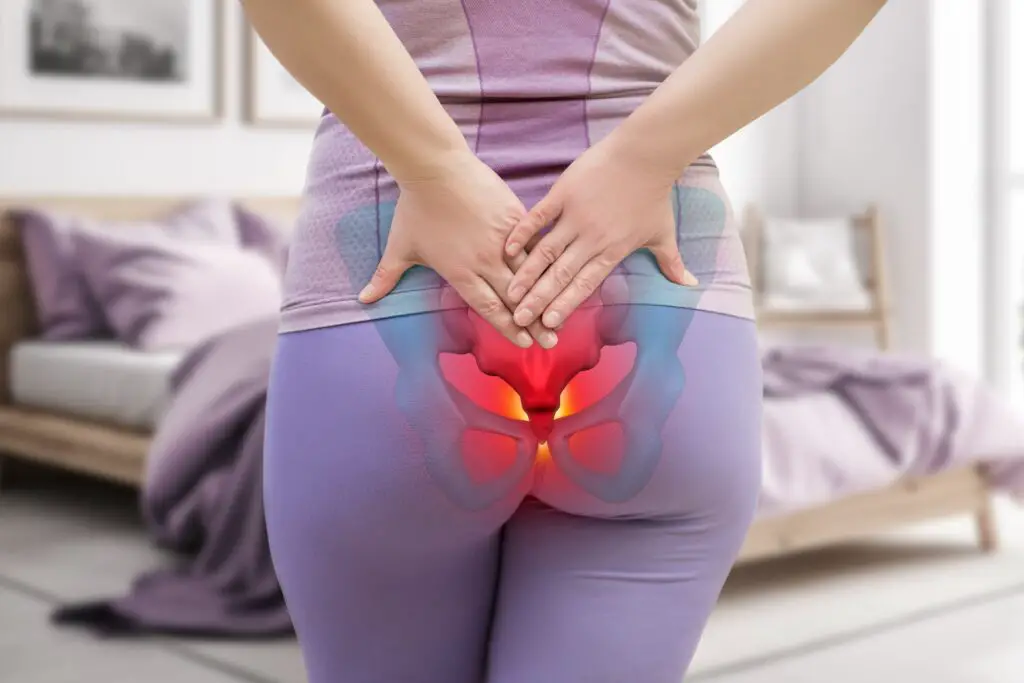Table of Contents
Pregnancy causes many changes in the body, which can induce different pains. This article is about different ways you may experience inner thigh pain during pregnancy and the changes you may experience in the last weeks of pregnancy. It also highlights the mechanisms that lead to these pains and simple home remedies for them. Ever wonder if your pain is normal or concerning? Here you go and grab all these answers.
Causes of inner thigh pain during pregnancy and in the third trimester
Pregnancy is a physiological process lasting almost 40 weeks in normal cases. It involves a lot of hormonal and physical changes due to the new fetus forming inside your womb. These changes may bring discomfort, along with the excitement of welcoming a baby into this world (1).
There are various causes of thigh and calf pain in pregnant women. Inner thigh pain is particularly associated with symphysis pubis dysfunction (SPD). Our pelvic bones are actually the two bones, right and left; paired together beautifully through various ligaments and joints. To accommodate the baby in your womb, your pelvic bones go through the changes that make space for the baby. SPD results when these changes cause instability in the joint between both pubic bones (2).
Mechanism of the pain
Following are the possible ways of inner thigh pain: (3, 4)
- Changes in the anatomy of three pelvic bones that support the pelvis
- Mechanical pressure caused by the increased weight of the mother that especially occurs in the third trimester and the baby.
- Improper coordination of muscles of the lumbar and pelvic region.
- Hyperlordosis associated with pregnancy (lordosis is the inward curve at the lower back).
- Flexibility in ligaments joining the bones of both sides.
- Hormones such as relaxin may cause loosening of both pubic bones at their joining point.
- Progesterone also affects the stability of pelvic and lumbar joints (progesterone is a female hormone that increases during pregnancy).
- Change in center of gravity with increased abdominal girth also affects abdominal and pelvic muscle coordination and causes pain.
- Pain avoidance behavior (fear) also impairs the muscle forces and increases the pain. Such dysregulation of emotions is common in pregnancy.
- Metabolic changes such as calcium imbalance and some degenerative changes that particularly occur in malnourished females also increase the pain.
- A weak genetic association is also reported, showing if your sister or mother experienced such pain, you may also be predisposed to it.
Body changes during the third trimester
There are three trimesters in pregnancy. The whole period of pregnancy is divided into three parts, known as trimesters. The first trimester is from the 1st week through the 12th week, the second starts at the 13th week and ends at the 28th week, while the last one, the third trimester, is from the 29th week to the 40th week (1).
The third trimester seems to be the most difficult for most women because you may burn out with a lot of changes pregnancy has gifted you, and you may become impatient to hold your baby as soon as possible. Following are the changes that you may experience in your third trimester (5, 6, 7):
- Pain in legs, especially crampy pain because you have been putting increased weight on these legs, the blood volume of your body also increases, all these things put extra strain on legs.
- Body metabolic rate increases, causing increased body temperature, which is felt as if heat is radiating out from within the body.
- Blood vessels dilate so that the blood pressure may drop a little.
- Backaches, pelvic pain, and inner thigh pains are due to the physical changes in joint stability and pubic symphysis dysfunction as described above.
- Acid reflux is quite common as the hormone progesterone relaxes the inlet of the stomach. This causes acid reflux from the stomach back to the food pipe. (esophagus), which is felt as heartburn. That is why acid-producing foods such as citrus fruits are avoided, particularly in the last trimester.
- Increased frequency of urination: there are two reasons why you urinate more as you approach the end of pregnancy. First, the increased size of the uterus puts pressure on the bladder, causing frequent urination. Second, pregnancy increases the renal blood flow, which increases the size of kidneys to reach a maximum by the third trimester, and hence, more urine is produced.
- Increased hair growth, especially coarse hair
- Spider veins: swollen tiny red vessels appear on arms, face, neck, and legs due to increased blood flow and hormonal changes. Swollen veins also occur in legs named varicose veins; this is due to increased pressure in leg veins caused by greater womb size. Elevate your legs frequently. It will provide some relief.
- Hemorrhoids and constipation: swollen veins in the rectum are known as hemorrhoids. Also, due to stasis of bowel movements as a result of pressure by the uterus, constipation occurs. You can relieve these problems by eating a fiber-rich diet and taking a hot sitz bath.
- Stretch marks are more commonly found on the abdomen due to rapid skin stretching and increased baby size.
- Braxton hicks contractions: These are irregular or, you may say, labor-like contractions, but actually, they are called false labor because they do not lead to delivery.
- Breathlessness: oxygen demand increases with increased gestational age. This increased demand causes hyperventilation or, you can say, increased respiratory rate. Also, the uterus puts pressure on the diaphragm (a muscle just below the lungs and helps in respiration); these changes cause shortness of breath in later pregnancy. You should opt for the best posture, allowing maximum breathing.
- Your emotions may become exaggerated as you approach the delivery time. A lot of fears appear, especially in the first pregnancy. These include how it will happen, whether it will be painful, what if any complication arises, and how long the labor will be. Most women get anxious and emotionally disturbed near the delivery time.
Pregnancy is associated with a lot of body changes. Inner thigh pain is common in pregnancy and occurs due to variations in the strength of ligamentous attachments, joint stability, muscle coordination in the lumbopelvic area, and shifting of center of gravity during pregnancy. All these changes occur to accommodate the baby in your womb. Other changes that occur in the last trimester of pregnancy are backaches, breathlessness, heartburn, false contractions, stretch marks, varicose veins, frequent urination, and constipation.

Symptoms of symphysis pubis dysfunction
The pubic symphysis is a joint between the right and left pelvic bones at the anterior aspect of the whole pelvis. Symphysis Pubis Dysfunction (SPD) is also known as Pelvic Girdle Pain. This pain is quite common in pregnancy due to loss of stability and strength in the pubic symphysis (8).
The pain may feel like (8, 9):
- Pain on the front side of the pubis, in the center at the level of your buttocks
- Inner thigh pain
- Perineal area (the region between the anus and vagina)
- Lower back, either right or left side; sometimes on both sides.
- Sharp pain that may radiate from front to back
- Lower abdominal pain
Pain may exaggerate with certain postures and activities such as (8, 9):
- Walking
- Forward bending
- Postures when your legs get apart, such as coming out of a car
- Getting out of bed or changing posture while lying
- Going up or down stairs
- You may hear a clicking sound while walking
Associated symptoms include (9):
- Difficulty in urinating or passing stool
- Discomfort may affect your mental health and make you anxious, especially when it is associated with grinding sounds.
- Fatigue that is not related to any other pathology
Other medical conditions that can cause symphysis pubis dysfunction are (9):
- Sports injuries may affect the stability of pubic symphysis and can cause pain, just like in pregnancy.
- Age-related changes may affect this joint causing osteoarthritis (Degenerative joint disease).
- Infection or inflammatory conditions such as osteitis pubis may affect this.




Pubis symphysis is a joint between the right and left pelvic bones. The connecting tissue between this joint becomes weak in pregnancy, causing pain in the inner thigh, back, lower abdomen, and legs. This pain is exacerbated when you’re moving forward, using stairs, and walking. Other conditions that cause SPD are sports injuries, age-related changes, and inflammatory conditions.
Pain is common in pregnancy. But not every pain is considered to be alarming. Some pains are due to hormonal and physical changes in the body that occur as a result of normal pregnancy. At the same time, other pains are concerning as they may indicate that the matter is serious. Following are the symptoms of SPD that should make you visit your GP or midwife on an urgent basis (8):
- If the pain is making it difficult for you to move around, contact your healthcare provider as soon as possible.
- If going up or down stairs causes unbearable pain.
- If you cannot turn on the other side without assistance while lying down.
- Crampy lower abdominal pains as they may indicate preterm labor.
What to expect from your doctor
Your doctor may do the following steps to diagnose if the pain is related to SPD or some other etiology (9):
- First, a thorough history of some factors that can predispose you to SPD and favor this diagnosis. These factors are family history, multiparity, high weight, emotional factors, lack of routine exercises, or more than usual physical activity. (4)
- Physical examination, including palpation of the pelvic region, is needed to see any tenderness and the extent of joint instability. Your doctor may ask you to do certain movements to see how serious the problem is.
- Usually, imaging is avoided during pregnancy. Only ultrasound is performed to rule out pathological reasons for pain as it is considered a safe modality of imaging in pregnancy and not harmful for babies.
After ruling out other causes, your doctor will suggest different ways to combat this pain, including home remedies and medications, depending upon the severity of your SPD.
Different body pains are quite common in pregnancy, including inner thigh and pelvic pain. If the pain becomes unbearable or halts the minimal movements, it should be checked by a doctor who will diagnose the condition through proper history and examination.
How to relieve inner thigh pain during pregnancy: At home-tips
There are multiple home remedies to get relief from pelvic and thigh pains. Some proven ways are as follows (8, 9, 10):


Exercises
The most effective strategy to help with pelvic pains is good physiotherapy or exercises (8, 10). A few exercises that are particularly helpful are:
- Low-intensity gentle exercises, including stretching and prenatal yoga, are helpful for thigh pains. These stretching exercises include butterfly, adductor stretch, and seated side stretch. You can learn these exercises through one or two sessions with a physiotherapist (10).
- Butterfly: After sitting on the floor, both soles of your feet should meet. Gently bend your knees towards the floor while trying to keep your back straight. Repeat after a few seconds.
- Adductor Stretch: While standing, keep your feet slightly wider than the width of your buttocks. Slightly bend one knee and try to shift your weight on that side while straightening the other side. Keep bending until you feel the stretch in your straight leg. Repeat after a few seconds.
- Seated Side Stretch: sit on a chair and extend one leg at a time, along with flexing the foot of that leg. Do it until you feel a stretch in your thigh. Repeat this with the other leg, too.
- Exercises that strengthen your pelvic floor, buttocks, and abdominal muscles. This will also help in effective labor (8).
- Practice maintaining good posture and use your body mechanics in a way that alleviates the strain from your thighs. Again, this can be learned from a physiotherapist. (10)
- Sleeping Position: If you keep a pillow between your knees, it will help to lessen the pain. (9)
- Supporting belts for pelvis and crutches can also help (8)
- Comfortable footwear.
- Hot or cold compress.
- Avoid standing for too long; for example, you can dress up while sitting.
- While going in the car, you can squeeze your legs.
- Avoid lifting heavy weight objects.
- Paracetamol is safe in pregnancy and can be given for temporary pain relief.
Home remedies to alleviate the pelvic and thigh pain associated with normal pregnancy include stretching exercises such as butterfly, seated side stretch, and adductor stretch, maintaining good posture and good sleeping position, hot or cold packs, avoiding standing for too long as well as lifting heavy objects and taking paracetamol for temporary relief.




Why does my groin hurt during the 3rd trimester while stretching?
In the third trimester, your body makes room for the fetus. While doing so, it causes the stretching of ligaments around your womb. Round ligaments support the uterus, and when you stretch your body, extra strain is put on this ligament, which results in pain in the groin region. Another reason for groin pain is SPD, in which pelvic joints in front of the pelvis get weak to accommodate the baby and cause pain (2, 11).
At what week does pregnancy become uncomfortable?
The third trimester is the most uncomfortable period of pregnancy. It starts on the 29th week. This is because maximum growth occurs in this trimester, and your body goes through the maximum changes in this period to allow the fetus to grow in your womb. Also, you may get more anxious and impatient as the pregnancy advances (6).
What sitting positions should be avoided during pregnancy?
First of all, don’t sit in a single posture for more than 30 minutes. Do not sit with crossed legs. Maintain the height of your chair with respect to your table so that your shoulders remain relaxed and you can rest your arms and elbows on the table. Your sitting position should not stress your muscles. Avoid twisting your waist if you are sitting on the rolling chair. Also, avoid postures that involve bending forward (12).
What signs should you not ignore during pregnancy?
Some changes are normal in pregnancy, but some signs are dangerous. These include temperature above 100.4F, worsening headaches, changes in vision, vaginal bleeding, crampy abdominal pain, severe shortness of breath, massive swelling of the body, severe vomiting, and not feeling baby movements in later pregnancy (13).
Why can’t I sleep on my right side while pregnant?
Your womb compresses surrounding blood vessels in the abdomen during pregnancy. If you sleep on the right side, it will compress a great vein named the vena cava in the abdomen, which will cause swelling in the legs and also hinder the flow of blood back to the heart and ultimately to the fetus. So, sleeping on the left side is considered more optimal as it will not affect blood flow and will provide nutrition to the baby (14, 15).
Summary
Pregnancy induces different changes in the body. These variations cause discomfort, including inner thigh, pelvic, and back pains. It results in accommodating the newcomer in your womb. To make room for the fetus, joints and ligamentous attachments of your pelvic bones weaken in later pregnancy, also known as Symphysis Pubis Dysfunction (SPD). SPD causes abdominal, inner thigh, and back pain.
If the pain is crampy or makes it difficult for you to move even, you should consult with a doctor.
Home remedies for such pain include stretch exercises, hot or cold compresses, posture maintenance, and wearing supporting belts.

















Comments
0